Imhotep Overview
The ancient Egyptians are famous for their many inventions, their gifts to science and mathematics, their mummies, and their hieroglyphics, but they are probably most well known for their massive building projects. Their architectural achievements have withstood the ravages of time and stand as a testament to this once great empire. In the game of Imhotep, the players will compete to outsmart, outmaneuver, and outbuild each other as these monuments begin to take shape.
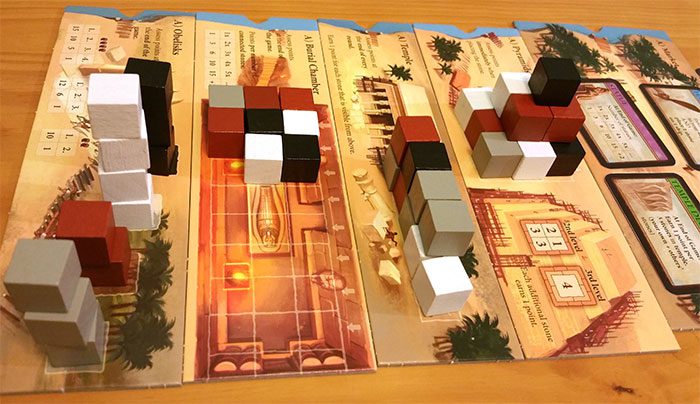
The rules are simple. Pick up stones. Place the stones on boats. Move the boats to a building site and offload them for points. The tricky part is knowing when to do these things and figuring out how to best perform these actions so that it leaves you in an advantageous position while leaving your opponents in a disadvantageous one.
Components

Imhotep is relatively small in size as far as components go. The box contains an assortment of large cubes in four different colors, several building site tiles, some boat tiles in various sizes, two decks of cards, and four sleds in four different colors. There is also a scoring track included along with a colorful and well-designed rule book.
The Setup
There are four different colors of stones and each player selects a color and takes all of the stones and the sled of the appropriate color into their possession. Next, the five building site tiles are laid out, one above the other, in order of how they are scored.
Some building sites score immediately when a stone is placed onto them. Some score at the end of a round. Others only score at the end of the game.
Furthermore, each building site has an ‘A’ side and a ‘B’ side. The ‘A’ side is used for a simpler game while the ‘B’ side adds some extra complexity. For each building site, one of these sides will be placed face up. They can be mixed and matched any way you like so long as the players agree upon the choices made.

Next, the market cards are shuffled and placed face down above the market building site. The top four cards are then drawn and laid face up into the market. Then the boat tiles are arranged by size and placed close by along with the boat cards which are shuffled and placed facedown on the table. The top boat card is then removed from the game face down so that only 6 boat cards remain.
Finally, a starting player is chosen and you are ready to begin.
The Round
Each round consists of a variable number of turns. During each player’s turn, they will be presented with one of three possible actions:
- Take up to 3 stones of their color from the quarry and place them onto their sleds. They may never exceed five stones in total.

- Place a stone onto a boat tile in any position on the boat tile that they wish. The boat tiles have a limited number of spaces to hold stones and it is not necessary to place the stones in any specific order.

- Move a boat to a building site and perform the actions associated with that building site. In order to move a boat, that boat must contain a certain number of stones. The number of stones needed to move the boat is illustrated on the boat tile. The stones are removed from the boats from from front to back until the boats are empty. The order in which the stones are removed is very important as you will soon discover.
At the beginning of the round, the top boat card is flipped over and this will tell the players which four boats are available for the round. Once all four boats have been assigned, the round will come to an end. The player to the left of the person that moved the last boat will be the starting player for the next round.
The Building Sites and End Game Scoring
Since an introductory game of Imhotep only uses the ‘A’ sides of the building tiles, I am only going to discuss those sides in this review. I will begin from the top of the tile layout and move downwards until I have discussed them all. We begin with…
The Market – as each stone is removed from the boat, the player whom the stone belongs to can claim any one of the available market cards. Some of these cards provide instant benefits. Others provide situational benefits and can be held to be used at a later time. Still, others will provide the players with additional victory points at the end of the game.
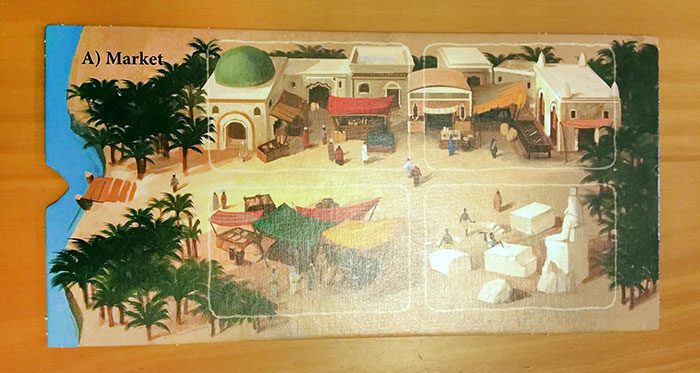
Pyramid – the Pyramid is divided into 3 layers. The bottom layer is a 3×3 grid. The middle layer is 2×2. The top layer only accepts a single stone. The stones are added to the pyramid in columns from top to bottom, left to right, beginning with the bottom layer. As each stone is added, the player who the stone belongs to will score a number of points according to the value shown on the space.

The Temple – there is a row of squares on this tile. Each of these squares can accommodate a stone. The stones are placed onto the temple row from left to right. When the row fills up, a new row is started on top of the existing one. The Temple is scored at the end of each round. Each player will score a point for each of their stones that can be seen looking down from above.
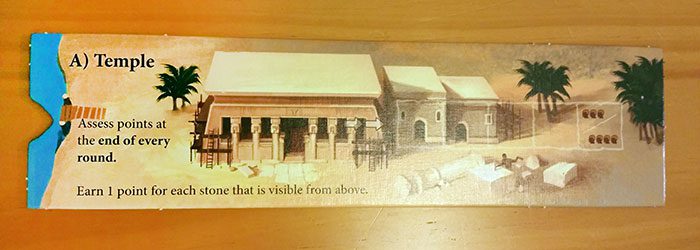
The Burial Chamber – much like the Pyramid, stones are added to the Burial Chamber in columns from the top down. However, this is where the similarities end. Unlike the Pyramid, the stones added to the Burial Chamber are only placed into a single layer. At the end of the game, the players will score points based on how many stones of their own color are touching one another. The more stones touching one another, the higher the score.
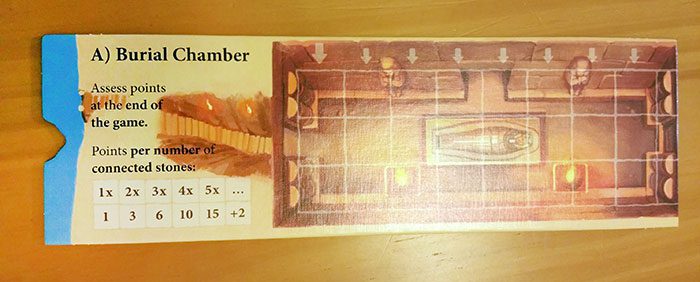
The Obelisks – there is a square of each color on this tile. The players will place each stone delivered here onto its appropriate space. Any stone beyond the first is stacked atop any stones that are already there. At the end of the game, the player with the tallest obelisk scores some points. The second highest scores less points and the third highest scores even fewer. The fourth highest scores even less than that.
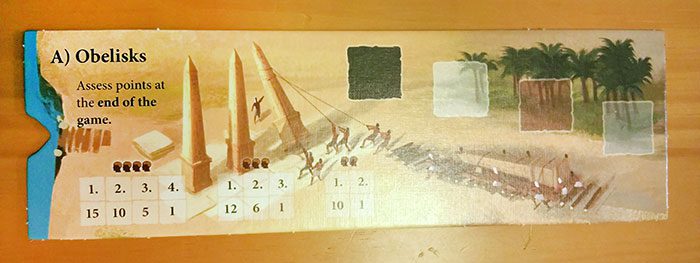
The entire game only lasts six rounds (the same number of boat cards that were laid out during the setup phase). At the end of the sixth round, the final scoring takes places. Players will score their points from the Burial Chamber and the Obelisks. At this time, they will also score any points awarded to them by the cards that they may have obtained from the market. The player with the most points is the winner.
Thoughts
For starters, Imhotep is a great looking game. The colors are rich and vibrant. The artwork is very well done. And the various components are all top notch quality. The cubes are very large and have a nice tactile quality about them. I’m a big fan of the smaller cubes that you’ll typically find in most board games that use cubes in some form or another, but I really like these. They work very well here. As far as looks go, Imhotep gets a thumbs up from me.
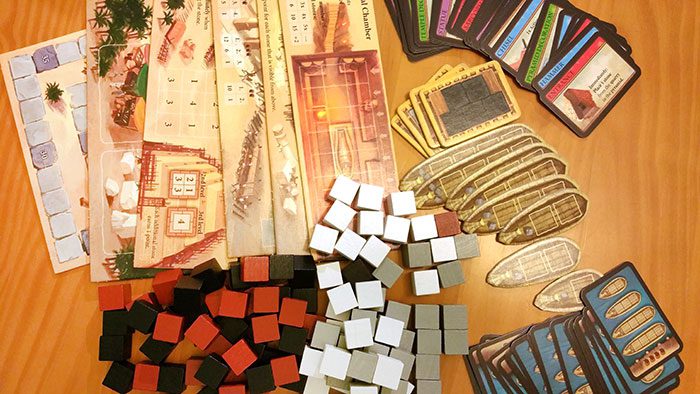
Imhotep is definitely not a game where you can build up an engine and then set it loose to see where it takes you. In fact, it’s quite the opposite. With the way that it is constructed, it is inevitable that your plans will be thwarted at almost every turn and your hopes and dreams will be crushed mercilessly. And really, that is where most of the strategy comes from.
You’re constantly going to be put in the position of having to make some tough choices. Taking stones could mean giving your opponents the opportunity to move the boats to a building site that greatly benefits them while not benefiting you very much. On the other hand, simply moving a boat to an undesirable location in that situation could spell disaster for you in the long run since you will be at a disadvantage when it comes to offloading stones. If you can’t place stones, then you’re not going to be scoring very many points. For such a small game, there are a lot of situations like these that will definitely keep you engaged and on your toes.
As you can surmise from my previous statements, there is a lot of player interaction in this game. Being able to move the various boats before they are filled up provides the players plenty of opportunities to screw their opponents. In general, plenty of player interaction is usually a good thing. Here, however, it can feel sort of soul crushing at times as your grand design gets trampled on again and again and again and you start falling way behind everyone else on the scoring track. This is about the only negative that I can find about this game. Like any game, when you’re actually in the running for the winner’s circle, the game feels exciting and fun, but when you’re falling way behind the pack, it feels pretty hopeless and that sucks the joy right out of it.
Don’t let that chase you away, though. Overall, it’s a very good game and I have a really good time playing it. I think you will, too.
If you love the original Imhotep, but are looking for a better two player option, check out Imhotep: The Duel; a version of the game designed just for two players!












